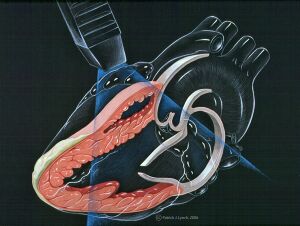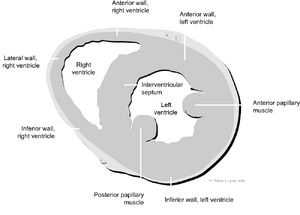ECHO course: Difference between revisions
No edit summary |
No edit summary |
||
| Line 1: | Line 1: | ||
{{DevelopmentPhase}} | |||
=Standard Imaging Planes= | =Standard Imaging Planes= | ||
Revision as of 06:25, 21 September 2007
Content is incomplete and may be incorrect. |
Standard Imaging Planes
Imaging of the heart by means of ultrasound is limited by thoracic anatomy. Air doesn't propagate ultrasound and because of this imaging of the heart is limited to several so-called 'acoustic windows'. These windows are left parasternal, apical, subcostal, suprasternal and right parasternal. Because of the properties of ultrasound intrathoracic fluid (for instance pleural or pericardial effusion) makes imaging easier but more intrathoracic air (COPD) makes imaging more difficult.
Parasternal Imaging Planes
The left parasternal imaging planes are found by placing the transducer in the third or fourth intercostal space on the left of the sternum. There are four standard imaging planes:
- parasternal long axis (PSLAX) and
- three parasternal short axis planes (SAX).
Left parasternal long axis
| <flash>file=PSLAX.swf |
| A parasternal long axis |
Left parasternal short axis
Apical Imaging Planes
There are three apical imaging planes. these are made by placing the transducer on the ictus cordis and thus getting a four chamber view. By rotating the transducer counter clockwise, the two and three chaber views respectively are seen.
- Apical four chamber view
- Apical three chamber view
- Apical two chamber view

